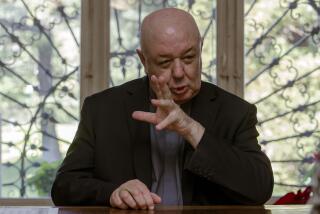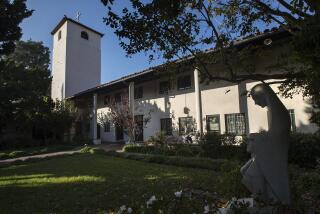Monks Ensure Past’s Future by Saving Medieval Scripts
- Share via
COLLEGEVILLE, Minn. — In an Ethiopian mountaintop monastery.
In a stable on the island of Malta.
In the ancestral castle of a German prince.
In every remnant of our medieval past, the manuscripts are sought.
They are wrinkled, some of them, and smudged--page after ancient page of parchment scribbled in a cramped and crabby script. Others are gorgeous, afire with art, shimmering with golden ink.
They may tell of St. George slaying the dragon. Or relate a recipe for stew. They may tote up a carouser’s debt. Or explain a surgical technique.
But this they have in common: They are old. They are rare. And the monks of this modest town are determined to find and preserve them.
Indeed, the Benedictine monks of St. John’s Abbey here have set themselves a most audacious goal. They aim to photograph and catalog every page of every text written in Europe, the Middle East and North Africa before the invention of printing.
They want, in short, to preserve--on microfilm--the cultural heritage of Western civilization.
It is a job for the eons.
They have a good start: In the last 35 years, they have photographed more than 25 million pages. Some foreign curators have refused to cooperate, unwilling to share control of cherished manuscripts, reluctant to let even copies of the texts out into broad circulation. Still, through persuasion and persistence, the monks have accumulated about 200 miles of microfilm. They have ensured that scholars for generations will be able to study the lyrics to Gregorian chants, the astronomical calculations of the 13th century, the lavish illustrations for a Persian epic poem--even if the original manuscripts crumble or mold or burn.
In a vault beneath the frosty expanse of central Minnesota, the monks of St. John’s have amassed the world’s most comprehensive collection of medieval texts on microfilm.
But there’s plenty still out there.
“Enough to keep us going for another 500 years or so,” said Father Eric Hollas.
The task sounds dusty and grindingly dull. Search, find, photograph, catalog. Search, find, photograph, catalog.
There’s drama in it, however: The mystery of deciphering old texts, the peril of climbing rope ladders to reach mountaintop abbeys tucked in among the clouds. There’s humor too: One researcher collecting manuscripts on medieval Malta found an account of a woman so fed up with her husband that she journeyed three days by boat and donkey to denounce him to the Grand Inquisitors--for the alleged offense of eating meat on Fridays. (He was let off the hook with a warning.)
Above all, there is a sense of mission.
In the Middle Ages, most copying of documents fell to monks. The brothers of St. John’s consider themselves heirs to that tradition, armed with better technology but the same drive to share and preserve precious knowledge.
“I got this feeling as we handled the manuscripts,” said Father John Kulas, who oversaw microfilming in Germany last fall. “Here you have the work of a monastic scribe who copied this text [in medieval days]. And here you are, 1,000 years later, another monastic scribe recreating the manuscript in another medium so it can survive another 500 years.”
Or as Theresa Vann, a medieval scholar who curates the Malta collection, put it: “It’s good to be part of something bigger than yourself.”
Legend has it that the microfilm project was inspired shortly after World War II, when Pope Pius XII, alarmed at the indiscriminate destruction of Europe’s great treasures, asked: “What’s going to happen to the manuscripts?” The pope had good reason to be concerned. Bombs had blasted libraries, churches and castles. Desperate refugees had burned surviving texts for warmth.
“People tried to rebuild the medieval cities,” Hollas said, “but no one even tried to recreate the manuscripts.”
Still, the loss wasn’t total. An estimated 1 million of the West’s founding texts--calculations charting the movement of the stars, philosophies championing representative government, law books, sermons, zoological tables--survived the war intact. The 200 monks at St. John’s Abbey knew they couldn’t protect the fragile manuscripts forever. But, spurred by the papal plea, they vowed at least to preserve the contents.
Backed by foundation grants and private donations, the monks in 1965 began microfilming the collection of an 8th century Austrian abbey.
In years since, abbey monks have directed the filming of about 90,000 volumes--most written before 1600--in Spain, Germany, Ethiopia, Malta, Switzerland and Portugal. The project has built a $3-million endowment, with 10 full-time staff members at the Hill Monastic Manuscript Library on the campus of St. John’s University here in Collegeville, a farm town 90 miles northwest of Minneapolis.
It’s an unlikely place for a medieval treasure trove.
But academics the world over have found their way here--not only medieval scholars but also art historians drawn by the elaborate illustrations and calligraphers captivated by the soaring scripts.
Although microfilm can’t capture every nuance of an original document--some marginal notes may be lost, for instance--scholars find the medium exceptionally efficient. Rather than traipsing across Europe to track down old texts, researchers can simply request copies from St. John’s or from smaller medieval microfilm collections at St. Louis University and the University of Notre Dame.
And, although staring at a blotchy screen lacks the thrill of handling 500-year-old parchment, microfilm has its advantages: “You can print out what you need and stick it in your briefcase to read on the train,” medieval historian Paul F. Gehl said. “For the scholar, it’s an incredible boon.”
Hoping to appeal to the public as well, St. John’s holds classes for students and senior citizens. Browsing the collection is free. And actual medieval manuscripts on display give some texture to the featureless reels of microfilm.
Admittedly, much in the collection is obscure; unless you’re an expert, it’s hard to get worked up about 16th century letters on Italian property holdings. Some texts, however, open wonderful windows on the past. A 14th century watercolor of the Knights of Malta setting off on a crusade echoes with the clink of armor and the creak of wooden boats. A prayer book picture of a farmer slaughtering his pig for Christmas retraces modern holiday traditions half a millennium.
In preserving, cataloging and interpreting such manuscripts, the Hill Library staff is “doing something far beyond mere archiving,” said Mark Gleason, vice president of the Minnesota Humanities Commission. “They have taken what is esoteric and made it of great value to a broad group of people.”
But not everyone appreciates the monks’ goal of making the manuscripts accessible. Indeed, several foreign libraries have resisted opening their collections to the microfilm project.
“They fear losing control,” Kulas explained. Although they retain the original manuscripts--and rights to the microfilm--”they may be reluctant to let their treasures out of the country.”
Sometimes a deeper fear blocks cooperation. Guardians of manuscripts in Ethiopia, for example, worry that if their collections are made public, burglars will loot them--or politicians will find an excuse to seize them. “The best thing for them to do is to tell people they don’t have anything of value,” said Getachew Haile, an Ethiopian scholar who helped St. John’s overcome this obstacle and track down key caches of documents in the early 1970s.
For 10 years, the monks managed to film in Ethiopia, carting manuscripts by donkey, camel and Land Rover from remote churches to a photo studio in the capital.
Among their remarkable discoveries: the Book of Jubilees and the Book of Enochs, two texts written around the time of the Bible. Ethiopian scribes had copied these books again and again over the centuries, preserving--in the African language ge’ez--their take on philosophy, theology and daily life in the time of Christ. All European copies of the books had long since vanished by the time the St. John’s crew discovered the Ethiopian versions--and brought them back, on microfilm, for scholars to parse.
Despite such triumphs, Haile considers the Ethiopian project incomplete. He estimates that St. John’s filmed just 20% of his country’s ancient manuscripts before leaving in the mid-1980s as Ethiopia’s relations with the U.S. deteriorated. Worse yet, he suspects many of the most precious remaining texts have since been smuggled out of the country and sold.
“The loss is continuous,” he said.
Not that microfilm guarantees against loss. Like paper, it eventually deteriorates. So in time--two centuries, or three, or five--the ancient scribbles stored here will again need rescue.
The monks of St. John’s aren’t worried. They predict that new technology will be along to help by the time the microfilm fades.
And they trust that the scribes of the future--perhaps right here at their abbey--will copy their copies for the ages once more.
More to Read
Sign up for The Wild
We’ll help you find the best places to hike, bike and run, as well as the perfect silent spots for meditation and yoga.
You may occasionally receive promotional content from the Los Angeles Times.






